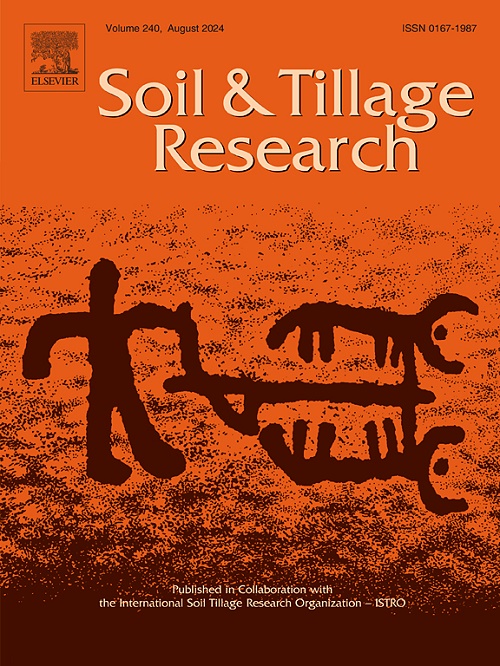Biochar and straw application reshape organic carbon pool via altering soil carbon pump function based on a decadal field experiment
IF 6.1
1区 农林科学
Q1 SOIL SCIENCE
引用次数: 0
Abstract
Soil organic carbon (SOC) accumulation is critical for maintaining agricultural production and combating climate change. Although organic amendments are commonly applied to improve SOC, the decadal-scale pathways controlling carbon sequestration remain largely unstudied. Here, a 14-year field experiment was utilized to investigate how biochar (BC) and maize straw (SW) regulate soil carbon pumps to impact SOC sequestration. The results showed that BC appeared to improve the efficiencies of both soil microbial carbon pump (MCP) via increasing microbial necromass carbon (MNC) in particulate organic matter (POM) (+90 %) and silt and clay fraction (SCF) (+35 %) and mineral carbon pump (MnCP) via increasing organic carbon (OC) in mineral-associated fractions (including SCF) (+104 %, namely 8.21 Mg C ha−1). Thus, BC enhanced SOC sequestration (+112 %) and promoted field crops growth (+10 %). The higher contribution of the SCF to SOC sequestration in the BC soil was attributed to its reducing carbon output potential, high accumulation of BC and amorphous Fe oxides, and increased Fe-bound OC. In contrast, SW only enhanced MCP operation by mainly promoting MNC concentration on POM (+151 %), which sequestrated SOC (+33 %) and increased crop yield (+7 %). While the low efficiency of MnCP in SW soil resulted from the more mineralization of abundant MNC and less Fe-bound OC within the SCF. A conceptual framework was presented whereby BC could drive both the MnCP and the MCP, resulting in significant potentials for SOC sequestration. Our findings offer valuable insights for optimizing agricultural management strategies to regulate SOC turnover and increase SOC sequestration.
基于年代际田间试验的生物炭和秸秆施用通过改变土壤碳泵功能重塑有机碳库
土壤有机碳(SOC)积累对于维持农业生产和应对气候变化至关重要。虽然有机修正通常用于改善有机碳,但控制碳固存的十年尺度途径仍未得到广泛研究。通过14年的田间试验,研究了生物炭(BC)和玉米秸秆(SW)调节土壤碳泵对有机碳固存的影响。结果表明,BC通过增加颗粒有机质(POM)和粉土和粘土组分(SCF)中的微生物死质碳(MNC)(+90 %)提高土壤微生物碳泵(MCP)的效率(+35 %),通过增加矿物相关组分(包括SCF)中的有机碳(OC)(+104 %,即8.21 Mg C ha - 1)提高矿物碳泵(MnCP)的效率。因此,BC增强了有机碳固存(+112 %),促进了大田作物生长(+10 %)。SCF对BC土壤有机碳固存的贡献较高,主要归因于其还原碳输出潜力、BC和无定形Fe氧化物的高积累以及Fe束缚OC的增加。相反,SW仅通过促进POM上的MNC浓度(+151 %)来增强MCP的运行,而POM上的MNC浓度增加了有机碳(+33 %),增加了作物产量(+7 %)。而西南偏南土壤的低效率是由于土壤中丰富的微量元素矿化程度较高,而土壤中含铁的有机碳较少。提出了一个概念框架,其中BC可以驱动MnCP和MCP,从而产生巨大的SOC封存潜力。本研究结果为优化农业管理策略以调控有机碳周转和增加有机碳固存提供了有价值的见解。
本文章由计算机程序翻译,如有差异,请以英文原文为准。
求助全文
约1分钟内获得全文
求助全文
来源期刊

Soil & Tillage Research
农林科学-土壤科学
CiteScore
13.00
自引率
6.20%
发文量
266
审稿时长
5 months
期刊介绍:
Soil & Tillage Research examines the physical, chemical and biological changes in the soil caused by tillage and field traffic. Manuscripts will be considered on aspects of soil science, physics, technology, mechanization and applied engineering for a sustainable balance among productivity, environmental quality and profitability. The following are examples of suitable topics within the scope of the journal of Soil and Tillage Research:
The agricultural and biosystems engineering associated with tillage (including no-tillage, reduced-tillage and direct drilling), irrigation and drainage, crops and crop rotations, fertilization, rehabilitation of mine spoils and processes used to modify soils. Soil change effects on establishment and yield of crops, growth of plants and roots, structure and erosion of soil, cycling of carbon and nutrients, greenhouse gas emissions, leaching, runoff and other processes that affect environmental quality. Characterization or modeling of tillage and field traffic responses, soil, climate, or topographic effects, soil deformation processes, tillage tools, traction devices, energy requirements, economics, surface and subsurface water quality effects, tillage effects on weed, pest and disease control, and their interactions.
 求助内容:
求助内容: 应助结果提醒方式:
应助结果提醒方式:


